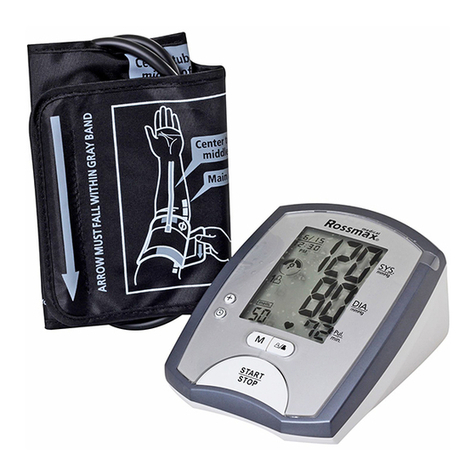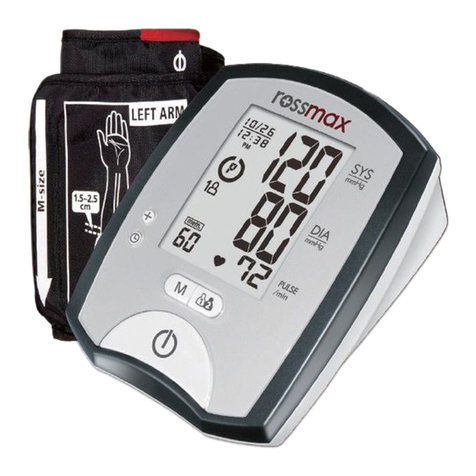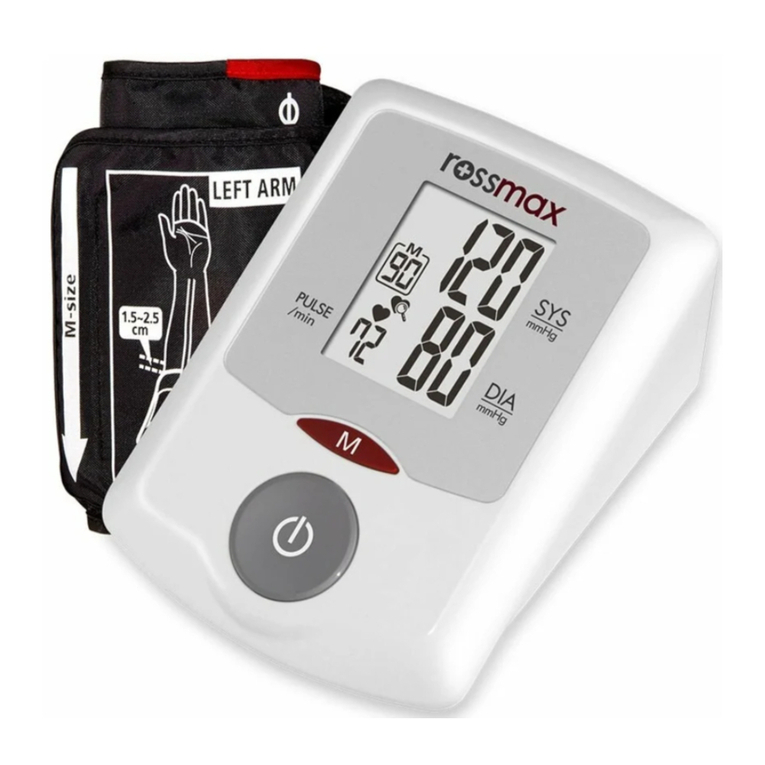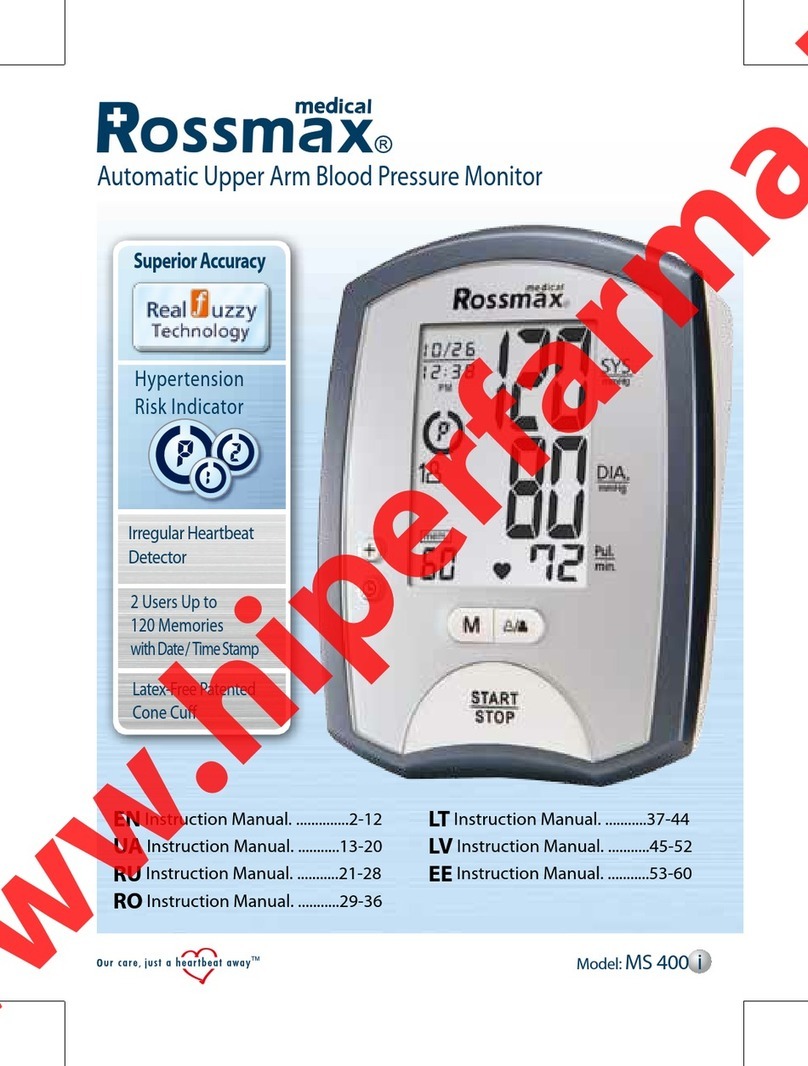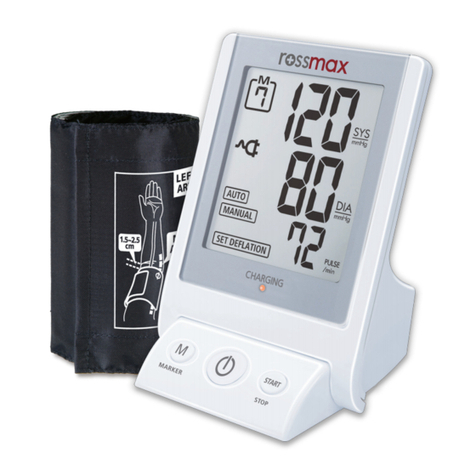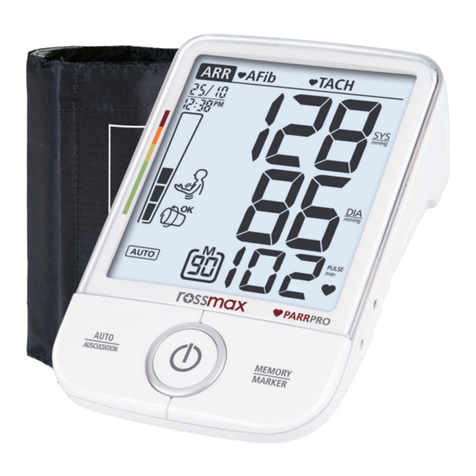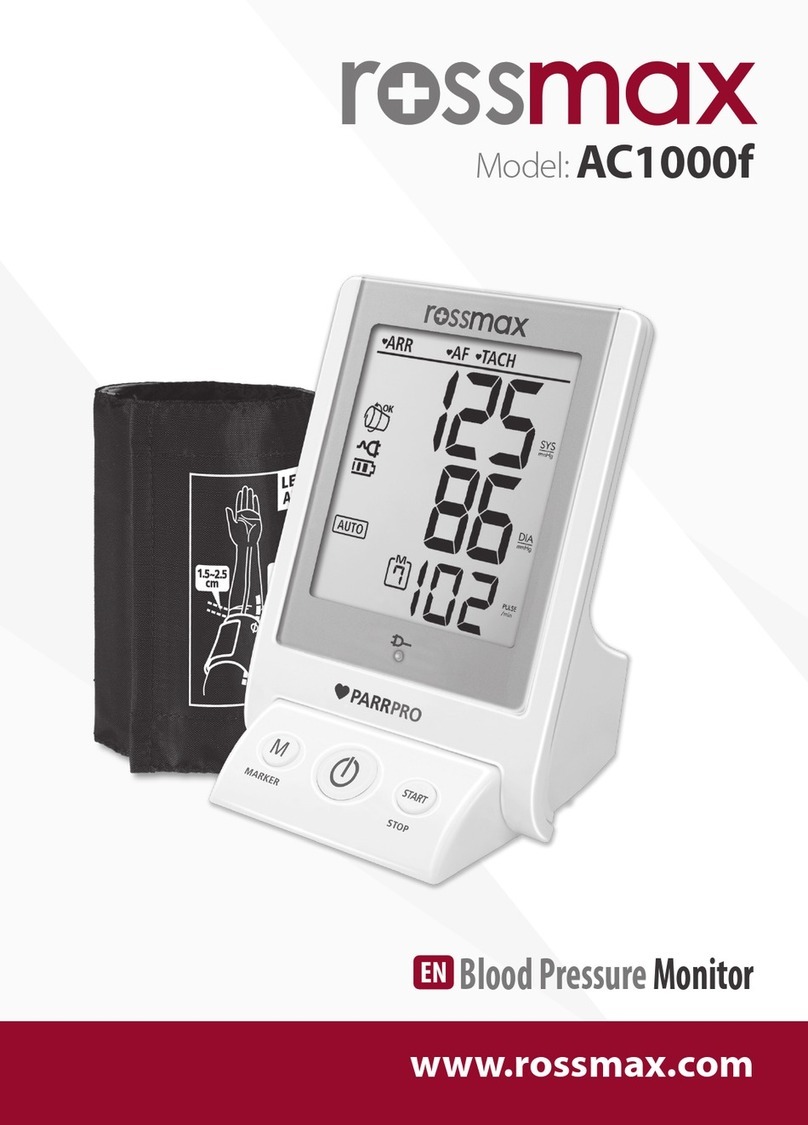1. To recall stored blood pressure readings from memory, simply
press the Memory key. The last set of memorized readings will
be displayed.
2. Another press of the Memory key will recall the previous set of
readings.
3. All readings stored in memory will be displayed with its sequence
number.
12. Recalling Values from Memory
13. Clearing Values from Memory
Press and hold the Memory key for approximately 5 seconds, then
the data in the memory zone can be erased automatically.
If any abnormality should arise during use, please check the
following points.
14. Troubleshooting
1. The unit contains high-precision assemblies. Therefore, avoid extreme
temperatures, humidity, and direct sunlight. Avoid dropping or strongly
shocking the main unit, and protect it from dust.
2. Clean the blood pressure monitor body and the cuff carefully with a slightly
damp, soft cloth. Do not press. Do not wash the cuff or use chemical cleaner
on it. Never use thinner, alcohol or petrol (gasoline) as cleaner.
3. Leaky batteries can damage the unit. Remove the batteries when the unit is
not used for a long time.
4. The unit should not be operated by children so to avoid hazardous situations.
5. If the unit is stored near freezing, allow it to acclimate at room temperature
before use.
6. This unit is not field serviceable. You should not use any tool to open the
device nor should you attempt to adjust anything inside the device. If you
have any problems, please contact the store or the doctor from whom you
purchased this unit or please contact Rossmax International Ltd.
7. As a common issue for all blood pressure monitors using the oscillometric
measurement function, the device may have difficulty in determining the
proper blood pressure for users diagnosed with common arrhythmia (atrial or
ventricular premature beats or atrial fibrillation), diabetes, poor circulation of
blood, kidney problems, or for users suffered from stroke, or for unconscious
users.
8. To stop operation at any time, press the ON/OFF/START key, and the air in the
cuff will be rapidly exhausted.
15. Cautionary Notes
16. Specications
17. EMC guidance and manufacturer’s declaration
IN0AV151f000000XX
Issue date: 2011/05/03
www.rossmaxhealth.com
Measurement Method Oscillometric
Measurement Range Pressure: 40~250 mmHg; Pulse: 40~199 beats/ minute
Pressure Sensor Semi conductor
Accuracy Pressure: ± 3mmHg; Pulse: ± 5% of reading
Inflation Pump Driven
Deflation Automatic Air Release Valve
Memory capacity 90 memories
Auto-shut-off 1 minute after last key operation
Operation Environment 10°C~40°C (50°F~104°F); 40%~85% RH
Storage Environment -10°C~60°C (14°F~140°F); 10%~90% RH
DC Power Source DC 6V four R06 (AA) Batteries
Dimensions 145 (L) X 105 (W) X 75 (H) mm
Weight 384.5g (G.W.) (w/o Batteries)
Arm circumference Adult: 24~36 cm (9.4”~14.2”)
Limited Users Adult users
: Type BF :Device and cuff are designed to provide special
protection against electrical shocks.
*Specifications are subject to change without notice.
• Take your blood pressure at normal body temperature. If you are
feeling cold or hot, wait a while before taking a measurement.
• If the monitor is stored at very low temperature (near freezing),
have it placed at a warm location for at least one hour before
using it.
• Wait 5 minutes before taking the next measurement.
1. Press the ON/OFF/START key. All displays will appear for approxi-
mately one second before returning to “0”.
2. The unit will automatically inflate to the appropriate inflation level
based on the user’s pulse oscillations. Measurement will then be-
gin. It is important to remain still and quiet during measurement.
Any significant movement may affect measurment results.
3. When the measurement is completed, systolic, diastolic and
pulse will be shown simultaneously and be saved automatically in
memory system. Up to 90 memories can be saved.
4. Measurement is now completed. Press the ON/OFF/START key
to turn off the power. If no key is pressed, the unit will shut off
automatically in 1 minute.
This monitor will re-inflate automatically to approximately 220 mmHg
if the system detects that your body needs more pressure to measure
your blood pressure.
Note: 1. This monitor automatically switches off approximately 1
minute after last key operation.
2. To interrupt the measurement, simply press the Memory or
ON/OFF/START key; the cuff will deflate immediately.
3. During the measurement, do not talk or move your arm or
hand muscles.
EE / Measurement Error: Make sure the L-plug is securely
connected to the air socket and measure again. Wrap the cuff
correctly and keep arm steady during measurement. If the error
keeps occurring, return the device to your local distributor or service
center.
E1 / Air Circuit Abnormality: Make sure the L-Plug is securely
connected to the air socket on the side of the unit and measure
again. Another possible cause can be due to the short circuit of the
microphone embedded in the cuff. If the errors still occur, return the
device to your local distributor or service center for help.
E2 / Pressure Exceeding 300 mmHg: Switch the unit off and
measure again. If the error keeps occurring, return the device to
your local distributor or service center.
E3 / Data Error: Remove the batteries, wait for 60 seconds, and
reload. If the error keeps occurring, return the device to your local
distributor or service center.
Er / Exceeding Measurement Range: Measure again. If the error
keeps occurring, return the device to your local distributor or service
center.
No display when the ON/OFF key is pressed: Re-insert the
batteries in the correct positions.
Note: If the unit still does not work, return it to your dealer. Under no
circumstance should you disassemble and repair the unit by your-
self.
9. Once the inflation reaches 300 mmHg, the unit will start deflating rapidly
for safety reasons.
10. Please note that this is a home healthcare product only and it is not intended
to serve as a substitute for the advice of a physician or medical professional.
11. Do not use this device for diagnosis or treatment of any health problem or
disease. Measurement results are for reference only. Consult a healthcare
professional for interpretation of pressure measurements. Contact your
physician if you have or suspect any medical problem. Do not change your
medications without the advice of your physician or healthcare professional.
12. Electromagnetic interference: The device contains sensitive electronic
components. Avoid strong electrical or electromagnetic fields in the direct
vicinity of the device (e.g. mobile telephones, microwave ovens). These may
lead to temporary impairment of measurement accuracy.
13. Dispose of device, batteries, components and accessories according to local
regulations.
14. This monitor may not meet its performance specification if stored or used
outside temperature and humidity ranges specified in Specifications.
Guidance and manufacturer’s declaration-electromagnetic emissions
The AV151f is intended for use in the electromagnetic environment specied below.
The customer or the user of the AV151f should assure that it is used in such an environment.
Emission test Compliance Electromagnetic environment-guidance
RF emissions CISPR 11 Group 1 The AV151f uses RF energy only for its internal function. Therefore, its
RF emissions are very low and are not likely to cause any interference in
nearby electronic equipment.
RF emissions CISPR 11 Class B The AV151f is suitable for use in all establishments, including domestic
establishments and those directly connected to the public low-voltage
power supply network that supplies buildings used for domestic purposes.
Harmonic emissions
IEC 61000-3-2
Not applicable
Voltage uctuations/icker
emissions IEC 61000-3-3
Not applicable
Guidance and manufacturer’s declaration-electromagnetic immunity
The AV151f is intended for use in the electromagnetic environment specied below.
The customer or the user of the AV151f should assure that it is used in such an environment.
Immunity test IEC 60601 test level Compliance level Electromagnetic environment-guidance
Electrostatic
discharge (ESD)
IEC 61000-4-2
± 6 kV contact
± 8 kV air
± 6 kV contact
± 8 kV air
Floors should be wood, concrete or ceramic tile. If
oors are covered with synthetic material, the rela-
tive humidity should be at least 30%
Electrical fast
transient/burst
IEC 61000-4-4
± 2kV for power supply lines
± 1kV for input/output lines
Not applicable
Not applicable
Mains power quality should be that of a typical com-
mercial or hospital environment.
Surge IEC 61000-
4-5
± 1kV line(s) to line(s)
± 2kV line(s) to earth Not applicable
Not applicable
Mains power quality should be that of a typical com-
mercial or hospital environment.
Voltage Dips,
short interruptions
and voltage vari-
ations on power
supply input lines
IEC 61000-4-11
<5% UT
(>95% dip in UT) for 0,5 cycle
40% UT
(60% dip in UT) for 5 cycles
70% UT
(30% dip in UT) for 25 cycles
<5% UT
(>95% dip in UT) for 5 s
Not applicable
Not applicable
Not applicable
Not applicable
Mains power quality should be that of a typical com-
mercial or hospital environment. If the user of the
AV151f requires continued operation during power
mains interruptions, it is recommended that the
AV151f be powered from an uninterruptible power
supply or a battery.
Power frequency
(50/60 Hz) mag-
netic eld IEC
61000-4-8
3 A/m 3 A/m Power frequency maganetic elds should be at
levels characteristics of a typical loction in a typical
commerical or hospital enviroment.
NOTE: UT is the a.c. mains voltage prior to application of the test level.
Guidance and manufacturer’s declaration-electromagnetic immunity
The AV151f is intended for use in the electromagnetic environment specied below.
The customer or the user of the AV151f should assure that is used in such and environment.
Immunity test IEC 60601 test level Compliance level Electromagnetic environment-guidance
Conducted RF
IEC 61000-4-6
Radiated RF
IEC 61000-4-3
3 Vrms
150 KHz to 80 MHz
3 V/m
80MHz to 2,5 GHz
Not applicable
3 V/m
Portable and mobile RF communications equipment should be used no
closer to any part of the AV151f, including cables, than the recommended
separation distance calculated from the equation applicable to the
frequency of the transmitter.
Recommended separation distance:
d = 1,2 √P
d = 1,2 √P 80MHz to 800 MHz
d = 2,3 √P 800MHz to 2,5 GHz
Where P is the maximum output power rating of the transmitter in watts
(W) according to the transmitter manufacturer and d is the recommended
separation distance in metres (m).
Field strengths from xed RF transmitters, as determined by an electro-
magnetic site survey, a should be less than the compliance level in each
frequency range.vv
Interference may occur in the vicinity of equipment marked with the fol-
lowing symbol:
NOTE1: At 80 MHz and 800 MHz, the higher frequency range applies.
NOTE2: These guidelines may not apply in all situations. Electromagnetic propagation is affected by absorption and reection from
structures, objects and people.
a. Field strengths from xed transmitters, such as base stations for radio (cellular/cordless) telephones and land mobile radios,
amateur radio, AM and FM radio broadcast and TV broadcast cannot be predicted theoretically with accuracy. To assess the
electromagnetic environment due to xed RF transmitters, an electromagnetic site survey should be considered. If the measured
eld strength in the location in which the AV151f is u sed exceeds the applicable RF compliance level above, the AV151f should
be observed to verify normal operation. If abnormal performance is observed, additional measures may be necessary, such as
re-orienting or relocating the AV151f.
b. Over the frequency range 150 kHz to 80 MHz, eld strengths should be les than 3 V/m.
Recommended separation distance between
portable and mobile RF communications equipment and the AV151f
The AV151f is intended for use in an electromagnetic environment in which radiated RF disturbances are controlled. The customer
or the user of the AV151f can help prevent electromagnetic interference by maintaining a minimum distance between portable and
mobile RF communications equipment (transmitters) and the AV151f as recommended below, according to the maximum output
power of the communications equipment.
Rated maximum output
power of transmitter (W)
Separation distance according to frequency of transmitter (m)
150kHz to 80MHz / d=1,2√P 80MHz to 800MHz / d=1,2√P 800MHz to 2,5GHz / d=2,3√P
0,01 0,12 0,12 0,23
0,1 0,38 0,38 0,73
11,2 1,2 2,3
10 3,8 3,8 7,3
100 12 12 23
For transmitters rated at a maximum output power not listed above, the recommended separation distance d in meters (m) can
be estimated using the equation applicable to the frequency of the transmitter, where P is the maximum output power rating of the
transmitter in watts (W) according to the transmitter manufacturer.
NOTE1: At 80 MHz and 800 MHz, the separation distance for the higher frequency range applies.
NOTE2 These guidelines may not apply in all situations. Electromagnetic propagation is affected by absorption and reection from
structures, objects and people.

